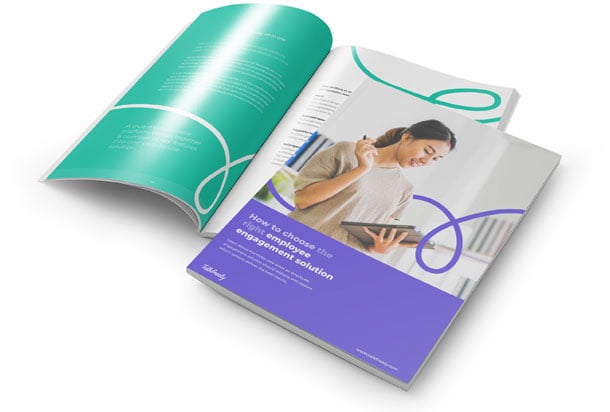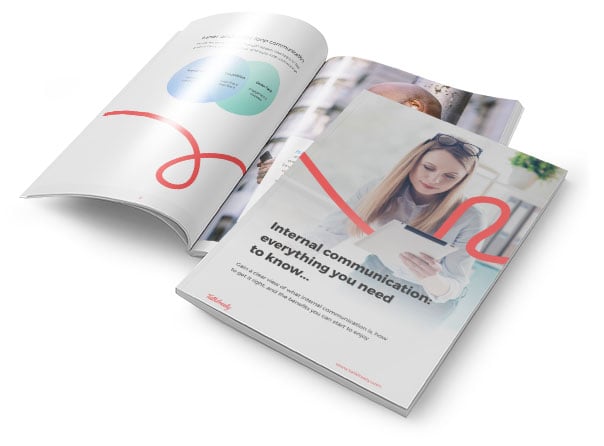If the events of the last few years have proved anything, it’s that the world of work is constantly evolving. The switch to remote working then developed into hybrid work patterns. And now we’re seeing a call for office workers to return to their desks. If we’re going to keep our internal communications working effectively, it’s crucial to keep updating our strategy to keep up with the changes.
All these changes have also made us more forward-thinking than ever before. Is the business prepared should another crisis hit? Are our communication channels up to the task? Now is the time to futureproof your business for whatever is coming next.
Businesses are taking a closer look at their internal communication strategy and evaluating whether it is still fit for purpose. Research by Deloitte suggests that only 47% of employers believed they had the capabilities or processes to meet a crisis with the best possible outcome.
It’s become clear that your strategy needs to address both on-site and off-site employees equally. The office remains the central hub of communication, but your channels must be up to the task of reaching every employee, wherever they may be. They also need to have a new level of immediacy. It’s no longer good enough to wait for everyone to open an email over a period of hours. The risk of misinformation and the need for guidance has never been greater.
The internal communications landscape has changed irrevocably, and we need to keep up.
This blog looks closely at what it takes to communicate effectively in this new arena. We explore seven key examples of internal communication where the challenge of business upheaval has been successfully managed and overcome. We also identify 12 quick-fix internal communication examples to improve employee engagement, whatever the situation.
7 Internal Communication Examples for the New Business Landscape
Incorporate some of the following internal communication best practices into your plans, and you’ll be making it ready to tackle the challenges of 2024 and beyond. These employee communication examples will help make your internal communications plan robust, flexible, and fit for the current business landscape.
1. Provide absolute clarity
In times of change, your employees need clear guidance without any hint of ambiguity. It’s natural for them to be worried and confused. They will inevitably have a lot of questions: “How will all the changes impact my role?”, “What are the new rules and processes?” “Will the reorganisation of the company mean I lose my job?”. This is a situation where effective internal communication is absolutely crucial. Even without a crisis in play, many employees feel they don’t have access to all the facts. A survey by Gallup revealed that 74% of employees feel they are missing out on important information at work. Your internal communication process needs to ensure everyone has access to the information they need and have all their questions answered.
Example
One example of internal communication to be particularly aware of is the risk of misinformation. If your employees don’t receive information from the company about internal reorganisation or role changes, they will seek the information themselves. Once your employees start calling their colleagues to find out the news, the risk of rumour and distortion rises dramatically. Communicating change needs to come from the top, and it needs to be as clear and well-defined as possible to avoid misunderstandings at this crucial time.
2. Deliver instant notifications
It’s abundantly clear that timing is everything in today’s business environment. To avoid spreading misinformation throughout your company, you must give answers and guidance immediately. This is not the time to say, “I’ll get back to you later”. You need to have those answers at your fingertips and get them out to your workforce immediately. Your employees don’t have the luxury of time to wait or search for critical information. According to Gallup, the average employee spends 2.5 hours per day looking for information they need. This time-lapse needs to be eliminated.
Example
When looking at examples of good internal communications, it quickly becomes apparent that your choice of channels is critical in 2024. Many companies discovered that their employee intranet wasn’t up to the task. While it may be great for sharing policy documents or company reports, it lacks the immediacy required in today’s working environment. Research by Medium shows that only 13% of employees use their company intranet daily.
This is where an internal communications app really comes into its own. The ability to send instant notifications to mobile phones is now essential. By ensuring that everyone receives the same message at exactly the same time, you’ll stop the gossip and fearmongering that can cause rumours to spread throughout an organisation.
3. Provide visible leadership
A strong leadership presence is crucial in times of change. Your senior team has a vital role in calming fears and reassuring employees as they steer the ship through choppy waters. They are ideally placed to act as crucial message carriers, and the tone they adopt will filter down through the company ranks. It’s also important to assign a clear role of responsibility for actioning both internal and external communication, ensuring there is clear corporate authority behind it. In times of uncertainty, direction needs to come from the top and cascade down through the organisation.
Example
Some examples of communication that make the most of leadership include video clips and audio messaging. While providing written documentation on any changes in direction and procedure is essential, people need to see a familiar face and hear a familiar voice to gain that extra reassurance.
There are many internal communication channels you can deploy to deliver this, including YouTube and WhatsApp groups. However, a dedicated app will give an added level of security. In addition, by giving employees a choice of devices to access communications, you will gain far greater reach across the company.
4. Segment your messages
One requirement that has become increasingly important is the need for segmentation. With workers now dispersed between the office and the home, it’s become vital to segment the content you’re sharing internally. Now, businesses are finding they need to send out personalised messages tailored to suit the audience in question. If you want to improve internal communications, this is an excellent place to start, particularly during change and disruption. Sometimes, a company-wide message is precisely what’s needed. However, there are times when it’s essential to ensure employees receive only the information they need and nothing more.
Example
Segmenting your content is even more critical in times of disruption and change. To avoid errors, you need to ensure that the message only reaches the correct segment of staff. Internal communications software will give you the flexibility to segment your content based on departments, teams, business units, and remote and office-based staff.
5. Provide social spaces
How can you get your office workers to connect meaningfully with your remote workers? It’s a new challenge for a new working environment. And it’s essential to get right if you want to avoid an ‘us and them’ situation developing. With an increasingly dispersed workforce, online social spaces have become an essential internal communications solution. Provide your employees with a digital space to connect, and you’ll foster that all-important spirit of collaboration. People are keen to reconnect, too. You’ll find that your employees jump at the chance to reach out to their colleagues on a social level.
Example
There are many ways of creating social spaces for your staff. You could develop a platform for sharing expertise. You could set up a social group for like-minded employees. Or you could create a project-driven space for everyone to share their ideas and suggestions. These spaces can be open to all or limited to specific members as required, and they’re a great way to promote equality across the workforce. In fact, we’re already seeing social spaces becoming one of the key internal communication trends of 2024.
6. Provide feedback channels
In times of change, employees will inevitably have questions. Lots of them! They will want to know about the impact of new working requirements on their roles and how they will affect the internal structure of the company. The benefits of good internal communication really come into their own if you can answer these questions quickly and directly. Fail to do this, and rumours will spread quickly across the company.
The answer is to make it easy for those questions to be asked and answered. You need to put feedback channels in place that will collect and process the questions and concerns of your workforce.
Example
When it comes to collating feedback, there are many internal communication ideas that can be put in place. For example, using an internal communications app you can create a channel dedicated to those returning to the office, inviting employees to post and share their questions. By providing a platform dedicated to your employees’ needs, you will remove uncertainty and encourage open discussion. Once you have a free-flowing two-way information channel, confidence and certainty will return to your workforce.
7. Measure your impact
Knowing whether your communications are being received and understood is vital. But in times of change and uncertainty, this need becomes acute. If employees are not receiving key messages, productivity could be compromised. You need to know whether your employees are reading your content and updates. You also need to understand which employees are not reading them and address the situation immediately. Conducting an internal communications audit is not a nice-to-have policy; it is essential.
Example
Protocol and procedural changes, along with health and safety updates, are among the most important examples of internal communication in an organisation. This is where a good app comes into its own, with the ability to fire out real-time notifications to every mobile phone across the organisation. Every employee instantly receives a text, and you receive a detailed report of who has opened the text and who hasn’t. It’s a highly effective method of internal communication.
12 Examples of Internal Communication to Put in Place Today
These internal comms examples highlight the need to keep your content interesting, relevant and varied. They’re easy to implement and will immediately impact your response rates. Keep these elements your top priority, and you’ll find your internal communications are read, absorbed and enjoyed.
Internal Communication Example #1: Employee Accomplishments
When an employee performs well, shout about it. It’s the simplest way to show staff you value hard work and success. As the saying goes: “criticise in private, praise in public”. Celebrating staff achievements is one of the key internal communication best practices that dramatically affect engagement levels.
Internal Communication Example #2: Team Accomplishments
It’s not just individuals who value praise. Recognising a team or a department as a whole creates a sense of unity, as well as personal feelings of pride in a job well done. It’s also a great way to spread knowledge throughout the company. Incorporating team acknowledgements into your internal communications plan will reap the rewards long after the actual announcement has been made.
Internal Communication Example #3: New Faces Profiles
Often overlooked, introducing new hires with well-targeted internal communication has multiple benefits. Along with making the new employee feel welcome, it will also give that crucial ‘insider’ information that generates high engagement levels. The importance of internal communication in successfully onboarding new employees should never be underestimated.
Internal Communication Example #4: Event Announcements
Company events are fantastic opportunities to build on engagement. Make the most of it by building excitement before the event with a detailed event announcement. It will boost attendance and ensure success, whether it’s a major trade show or a summer BBQ. A full and exciting events calendar should always be a top priority in your internal communication strategy.
Internal Communication Example #5: Company Successes
Everyone wants to feel they’re contributing to something meaningful. Tell employees when your company makes a splash in the industry. Once employees realise their actions have an impact that is felt industry-wide, they’ll feel like agents of change. And that’s a powerful motivator. One of the common errors is keeping staff out of the loop. Unless they think their role has a broader meaning, engagement levels will decline.
Internal Communication Example #6: Industry Bulletins
It’s not just your CEO who needs to keep abreast of industry news. All team members need to have access to the latest industry scoop. The key is to filter out the most relevant information, so you’re not swamping them with daily news. Internal communication trends for 2024 show an increased desire for current, relevant news.
Internal Communication Example #7: Video Communications
Video is engaging, it’s interactive, and it’s personable. In fact, it’s so good at meeting the requirements of today’s workforce, it’s become one of the critical methods of internal communication. According to a report by Melcrum, 93% of internal communication professionals believe that video has become essential.
Internal Communication Example #8: Push Notifications
If you really want to grab someone’s attention, push notifications are what you’re looking for. They’ll be incorporated with all good internal communications apps, and have the added benefit of allowing the employee to respond directly from their own device. This fact alone will push engagement levels through the roof.
Internal Communication Example #9: Questions and Answers
Give employees a channel for asking questions, and you’re guaranteed a good uptake. Often, staff don’t ask questions as they are never prompted to do so. But you’ll discover a wealth of untapped queries waiting to be asked. Collating feedback should be at the heart of your strategy.
Internal Communication Example #10: How-To-Guides
Concise and accessible guides focusing on relevant work issues will always be read and appreciated. Whether shared through a blog post, internal communications software, or video streaming, how-to instructions are a universally popular addition to company news. They are particularly useful when communicating change, offering an engaging way to explain new processes and procedures.
Internal Communication Example #11: Day-In-The-Life Stories
We’re all interested in the nitty-gritty details of our colleagues. Sharing the ins and outs of what Henry in Accounts does all day is a fascinating read. It builds that vital insider knowledge and creates a sense of camaraderie. These day-in-the-life diaries are an essential ingredient of every internal communications plan.
Internal Communication Example #12: Fun Office Moments
Enjoy the lighter times. As long as you’re careful not to embarrass people, sharing entertaining happenings around the office can break down barriers and build friendships. A recent survey from Wildgoose has found that having good friends at work leads to new levels of creativity and productivity.










